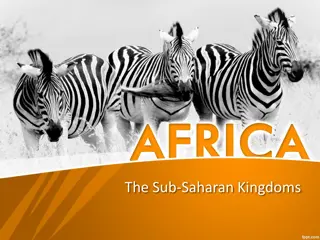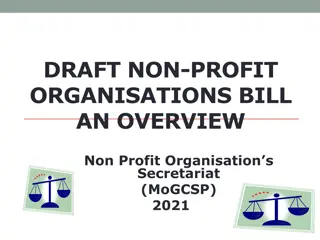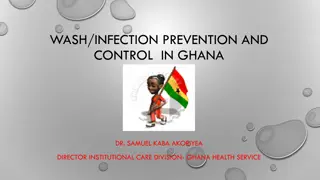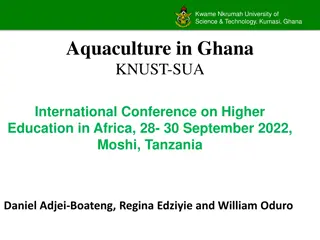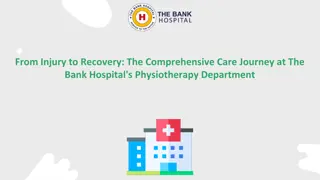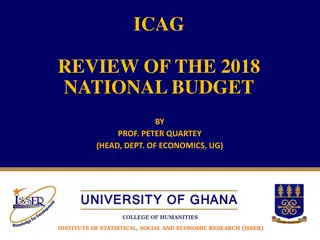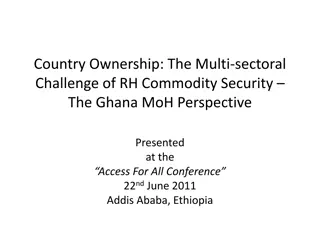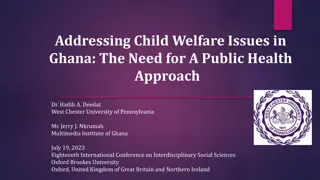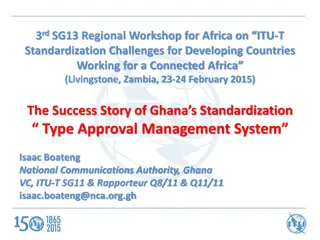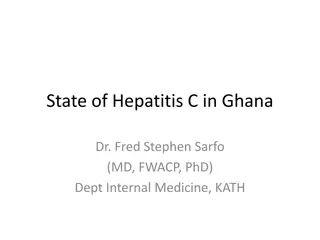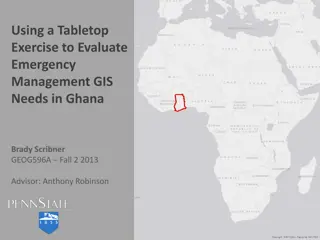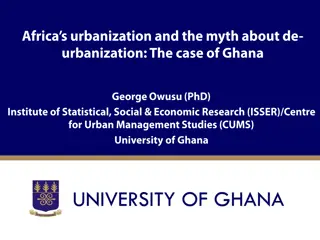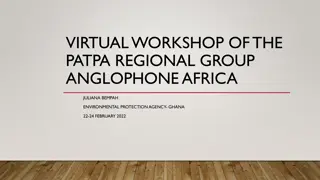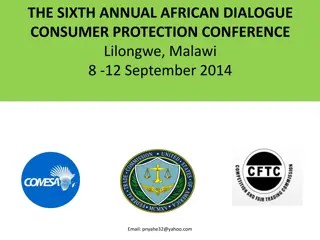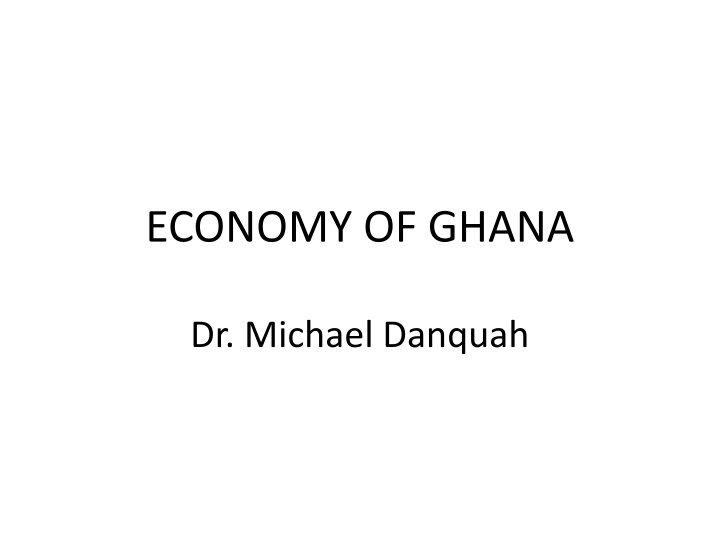
Accelerated Agricultural Modernisation in the Ghanaian Economy
Explore the key sectors driving Ghana's economic growth, with a focus on the agricultural sector and medium-term development policies. Learn about the goals, strategies, and initiatives to enhance productivity, create jobs, and boost competitiveness in agriculture. Discover how Ghana aims to achieve sustainable development through improved land and water management, crop development, and more.
Download Presentation

Please find below an Image/Link to download the presentation.
The content on the website is provided AS IS for your information and personal use only. It may not be sold, licensed, or shared on other websites without obtaining consent from the author. If you encounter any issues during the download, it is possible that the publisher has removed the file from their server.
You are allowed to download the files provided on this website for personal or commercial use, subject to the condition that they are used lawfully. All files are the property of their respective owners.
The content on the website is provided AS IS for your information and personal use only. It may not be sold, licensed, or shared on other websites without obtaining consent from the author.
E N D
Presentation Transcript
ECONOMY OF GHANA Dr. Michael Danquah
MEDUIM TERM NATIONAL DEVELOPMENT POLICY FRAMEWORKS
GSGDA (2014-2017) To achieve the medium-term per capita income target, an average oil inclusive real GDP growth rate target of, at least 10.6% and a non-oil real GDP growth rate target of at least 9.6% per annum are projected. The key sector to lead the overall real GDP growth rate is Industry which is projected to grow at an average annual rate of about 13.2%, followed by the Service sector with 10% and Agriculture with 6%.
policies and strategies to be implemented Ensuring and sustaining macroeconomic stability; Enhanced competitiveness of Ghana s private sector; Accelerated agricultural modernisation and natural resource management;
Oil and gas development; Infrastructure and human settlements development; Human development, productivity and employment; and Transparent and accountable governance
Accelerated agricultural modernisation The Agriculture Sector of Ghana comprises crops (including cocoa), livestock, fisheries and aquaculture, and forestry and logging sub-sectors. The sector predominantly of subsistence smallholder production units, with weak linkages to the Industry and the Services Sectors. It employs 41.3% of the active population and is dominated by women. is made up
broad objectives to be pursued under the MTDS improved agricultural productivity; accelerated Creation of Decent Jobs; increased competitiveness integration into international markets; agricultural enhanced domestic and and
reduced production and distribution risks/ bottlenecks in agriculture and industry, including developing irrigation and improving agriculture financing; sustainable environment, land and water management; promote selected crop development for food security, export and industry;
promote the development of Agriculture Estates; promote livestock development for food security and income; promote fisheries development for food security and income generation; improved institutional coordination for agricultural development. and poultry and aquaculture
specific interventions to be implemented over the medium-term Promote Agriculture Mechanisation; Improve science, technology and innovation application; Promote seed and planting material development; Increase access to extension services and re-orientation of agriculture education;
Improve institutional coordination for agriculture development; Increase private sector investments in agriculture; Improve post-production management Develop an effective domestic market;
Expand agriculture exports; Promote the development of Agriculture Estates. This will entail the provision of essential services largely by the private sector, including land clearance and preparation, machinery service centres, certified seeds and other inputs
Invest in the development of the three selected cash crops (Cocoa, Oil Palm, Cotton) and horticultural products for export and processing, as well as food crops (rice and maize) to ensure food security. Establish marketing organizations along the lines of the Ghana Cocoa Board to support the development of the other cash crops.
Encourage and facilitate FBOs and the private sector to establish Agriculture Estates in partnership with Government to support the selected crops. Rehabilitate viable existing irrigation infrastructure, promote their efficient utilisation and promote private sector participation in irrigation development, management and utilisation.
Support the private sector to establish feed mills in the country to support the poultry and aquaculture sub-sectors. Develop appropriate agricultural financing instruments including the warehouse receipts system and agriculture insurance scheme to mitigate the key risks faced by farmers.
Implement a Fishermens Life Insurance Scheme (FLIS) to provide coverage for the loss of life of both marine and inland fishermen when they go on fishing expeditions.
MEDIUM-TERM POLICIES AND STRATEGIES FOR HUMAN DEVELOPMENT, PRODUCTIVITY AND EMPLOYMENT
Provision of Quality Education Key Challenges - the growing disparities in access to quality education among socioeconomic groups, different geographical areas, and people with special needs; - - the growing demand for higher education among the demographically youthful population;
- poor quality of teaching and learning; - inadequate education infrastructure; - weak management and supervision capacity; - low access to quality science and technical education; and - insufficient materials for special schools.
Medium-term Policy Interventions Government s policies in the medium-term will focus on achieving the following broad objectives: - increase inclusive and equitable access to, and participation in education at all levels; - promote the teaching and learning of science, mathematics and technology at all levels; - improve management of education service delivery;
- improve quality of teaching and learning; - and ensure continued provision of life skills training and management.
Increasing Inclusive and Equitable Access to, and Participation in Quality Education at all Levels: The key strategies to be implemented to achieve the objective of inclusive and equitable access to, and participation in quality education are: -remove the physical, financial and social barriers and constraints to access to education at all levels; - expand delivery modes including distance education, - open schooling, - transition education and competency-based training for Technical and Vocational Education and Training (TVET);
- mainstream education of children with special needs; - convert the NFED into an agency and empower it to make the necessary interventions for life-long education; - roll out a programme for the attainment of universal access to free secondary education; - and bridge the gender gap.
Promote the Teaching and Learning of Science, Mathematics and Technology at all Levels: the policy interventions to be implemented will include: -ensuring that tertiary institutions adhere to the national policy on 60:40 admission ratio in favour of science, mathematics and technology; expand the Mathematics, Science and Technology Scholarships Scheme (MASTESS) and use it to attract majority of students into science and science-biased courses;
- and expand infrastructure and facilities in tertiary institutions to absorb the increasing number of qualified students. - Others include providing incentives for science, mathematics, technical and vocational teachers; - upgrading tools and equipment for teaching science, mathematics and technology subjects; - and encouraging the private sector to support initiatives in science education.
Improving the Management of Education Service Delivery: Management of education service delivery will be improved through policy interventions to be implemented over the medium term to consolidate it with the decentralised structures. This will entail the involvement of MMDAs in local determination, in consultation with the central education authorities, of the required staff numbers, responsibilities, functions, deployment and resources.
Improving the Quality of Teaching and Learning: The policy measures to improve quality of teaching and learning include -providing adequate supply of teaching and learning materials; reviewing and standardise curricula especially at the basic, TVET and Non-Formal Education levels; deploying adequately qualified teachers and improving teachers time-on-task;
expanding the Untrained Teachers Diploma Education (UTDE) programme to reduce the number of untrained teachers by, at least 50% in the medium-term; and accelerating institutionalisation of the In- Service Education and Training (INSET) programme at the basic level.

